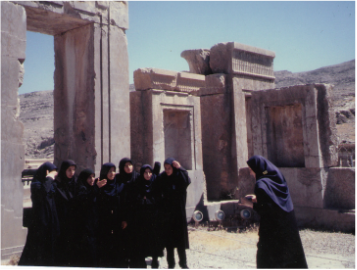
I was reminded of that trip when I read Rick Steves’ fascinating and important book Travel as a Political Act. One chapter in it describes his own recent trip to Iran. Often, when my wife and I travel to countries in the Middle East and beyond, we’re asked why? Aren’t we afraid? Rick Steves has the perfect answer to that question: “I learned,” he wrote, “that fear is for people who don’t get out much. The flipside of fear is understanding—and we gain understanding through travel.”
One place in Tehran that no one can miss is the State Jewels Museum – a vivid introduction to the life style of the late shah and Pahlavi family. The jewel collection of the deposed shah and his fun-loving relatives fills many steel-walled rooms in a bank basement. The spectacle is beyond impressive. The sad fact, of course, was that all this over-the-top magnificence came out of the flesh and blood of the Iranian people. As we trudged past the huge glass cases, we couldn’t help thinking, “No wonder the revolution overthrew the shah.”
The archeology museum was more interesting, since history here reaches back to the beginnings of civilization. As we wandered among massive Persian statues, bronzes from Luristan, and carvings from Susa and Persepolis, groups of students rushed up, chattering excitedly. The high school girls, clad like nuns in black manteaus (often with blue jeans peaking out underneath) were always the most eager. In fact, all across Iran, clusters of school girls and sometimes male students, smiled, practiced their English, and eagerly welcomed their country’s foreign guests.
The museum guide pointed out that it once held considerably more treasures, but many were smuggled out by the Pahlavi rulers before they fled the country. “Our national heritage,” he said, still indignant years later, “stolen by the shah and his family and now in private collections and museums around the world!”
American visitors often are driven past the huge walled complex of the former United States Embassy in Tehran. The grounds are overgrown and the buildings, glimpsed over the walls, are crumbling. What about the student occupation of the embassy and the Americans held hostage? Being there gave us a chance to view events through the eyes of the Iranians.
Iranians feel that the stage was set years before. Mohammed Mosaddegh, democratically elected Prime Minister of Iran in 1951, was overthrown in 1953 by a coup d’etat labeled Operation Ajax, orchestrated by the British MI5 and the United States CIA, under Director Alan Dulles, brother of Secretary of State John Foster Dulles. Why? Because, we were told, Mosadegh had nationalized the Iranian oil industry, which had been under British control since 1913.
Richard Nixon, when he was Eisenhower’s vice president, visited Tehran in December 1953, only four months after Operation Ajax, befriending the just-installed Mohammed Reza Shah Pahlavi, which infuriated Iranian students. When Nixon was given an honorary degree at Tehran University, students staged a massive demonstration. The shah ordered his troops to open fire. Three students were killed, many wounded, several hundred arrested. This caused such resentment in the country that the day has been remembered ever since as “Student Day.”
Their anger was flamed by the shah’s lavish lifestyle amid the wretched living conditions throughout the country. In October, 1971, in a multi-day extravaganza at ancient Persepolis, said to cost as much as $200 million.
“And in the towns around Persepolis,” we were told, “people were dying from polluted drinking water.”
In May 1972, Nixon returned to Iran, promising the shah that the U.S. would sell him weapons. The large protests during his visit showed how much the resistance to the shah’s regime was growing. By the fall of 1978, it was clear that he couldn’t survive and in January 1979, he fled. In November that year, a student demonstration outside the embassy against U.S. policies provoked U.S. Marines to shoot in the air, probably hoping to disperse the students. Instead, they climbed the compound wall and broke into the embassy. The guards shot and injured a number of students and embassy staff began shredding documents.
“The students discovered those shredded documents and pieced them together.”
From the patched-together documents, we were told, they discovered that the CIA and British MI5 were encouraging anti-Islamic revolution activities. The reaction around Iran was shock and anger. Ayatollah Khomenei declared “These are not diplomats with diplomatic privileges and rights, but CIA agents working against our government.” Women and staff with no authority for policy were released, but 52 were held as CIA agents and spies supposedly working against the Iranian government.
In the United States, we’ve received one version of those events. It was eye-opening to discover a different view of what happened then. In his book, Rick Steves quotes Mark Twain: “Travel is fatal to prejudice, bigotry, and narrow-mindedness.”
We had preconceptions about the people of Iran, but they had their own ideas about us, too. Everywhere, people stared openly at us, not with hostility but with surprise and curiosity. At one shrine, a group of boys followed us, trying out their few words of English. A boy about ten showed me his English class workbook. Proudly turning the pages, he pointed to where he had filled in the blanks in the various lessons.
Later, walking through the gardens, fifteen or twenty boys came up, one of them pulling out his notebook and ballpoint pen, and making writing motions. I printed, “Hello from the U.S.A,” and signed it. He read it, grinning broadly. Crowds of children waved as we left, calling, “Goodbye! Goodbye, friends!”
 RSS Feed
RSS Feed